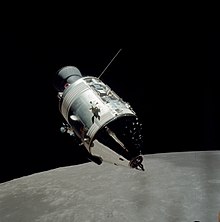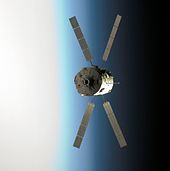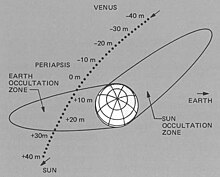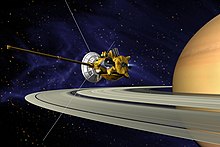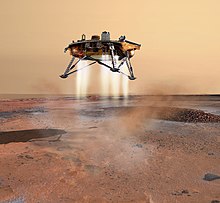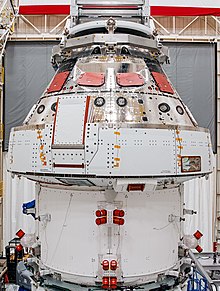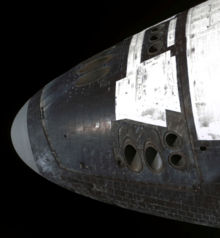A view of the Earth's atmosphere with the Moon beyond
Aerospace is the human effort in science, engineering, and business to fly in the atmosphere of Earth (aeronautics) and surrounding space (astronautics). Aerospace organizations research, design, manufacture, operate, or maintain aircraft or spacecraft. Aerospace activity is very diverse, with a multitude of commercial, industrial and military applications.
Aerospace is not the same as airspace, which is the physical air space directly above a location on the ground. The beginning of space and the ending of the air
is considered as 100 km above the ground according to the physical
explanation that the air pressure is too low for a lifting body to
generate meaningful lift force without exceeding orbital velocity.
Overview
In
most industrial countries, the aerospace industry is a cooperation of
public and private industries. For example, several countries have a
civilian space program funded by the government through tax collection, such as National Aeronautics and Space Administration in the United States, European Space Agency in Europe, the Canadian Space Agency in Canada, Indian Space Research Organisation in India, Japanese Aeronautics Exploration Agency in Japan,myanmar,RKA in Russia, China National Space Administration in China, SUPARCO in Pakistan, Iranian Space Agency in Iran, and Korea Aerospace Research Institute (KARI) in South Korea.
Along with these public space programs, many companies produce technical tools and components such as spaceships and satellites. Some known companies involved in space programs include Boeing, Cobham, Airbus, SpaceX, Lockheed Martin, United Technologies, MacDonald Dettwiler and Northrop Grumman. These companies are also involved in other areas of aerospace such as the construction of aircraft.
History
Modern aerospace began with Engineer George Cayley
in 1799. Cayley proposed an aircraft with a "fixed wing and a
horizontal and vertical tail," defining characteristics of the modern
airplane.
The 19th century saw the creation of the Aeronautical Society of Great Britain (1866), the American Rocketry Society, and the Institute of Aeronautical Sciences, all of which made aeronautics a more serious scientific discipline. Airmen like Otto Lilienthal, who introduced cambered airfoils in 1891, used gliders to analyze aerodynamic forces. The Wright brothers were interested in Lilienthal's work and read several of his publications. They also found inspiration in Octave Chanute, an airman and the author of Progress in Flying Machines (1894).
It was the preliminary work of Cayley, Lilienthal, Chanute, and other
early aerospace engineers that brought about the first powered sustained
flight at Kitty Hawk, North Carolina on December 17, 1903, by the
Wright brothers.
War and science fiction inspired scientists and engineers like Konstantin Tsiolkovsky and Wernher von Braun to achieve flight beyond the atmosphere. World War II inspired Wernher von Braun to create the V1 and V2 rockets.
The launch of Sputnik 1 in October 1957 started the Space Age, and on July 20, 1969 Apollo 11 achieved the first manned moon landing. In April 1981, the Space Shuttle Columbia launched, the start of regular manned access to orbital space. A sustained human presence in orbital space started with "Mir" in 1986 and is continued by the "International Space Station". Space commercialization and space tourism are more recent features of aerospace.
Manufacturing
Aerospace manufacturing is a high-technology industry that produces
"aircraft, guided missiles, space vehicles, aircraft engines, propulsion
units, and related parts". Most of the industry is geared toward governmental work. For each original equipment manufacturer (OEM), the US government has assigned a Commercial and Government Entity (CAGE) code.
These codes help to identify each manufacturer, repair facilities, and
other critical aftermarket vendors in the aerospace industry.
In the United States, the Department of Defense and the National Aeronautics and Space Administration
(NASA) are the two largest consumers of aerospace technology and
products. Others include the very large airline industry. The aerospace
industry employed 472,000 wage and salary workers in 2006. Most of those jobs were in Washington state and in California, with Missouri, New York and Texas also being important. The leading aerospace manufacturers in the U.S. are Boeing, United Technologies Corporation, SpaceX, Northrop Grumman and Lockheed Martin.
These manufacturers are facing an increasing labor shortage as skilled
U.S. workers age and retire. Apprenticeship programs such as the
Aerospace Joint Apprenticeship Council (AJAC) work in collaboration with
Washington state aerospace employers and community colleges to train
new manufacturing employees to keep the industry supplied.
Important locations of the civilian aerospace industry worldwide include Washington state (Boeing), California (Boeing, Lockheed Martin, etc.); Montreal, Quebec, Canada (Bombardier, Pratt & Whitney Canada); Toulouse, France (Airbus/EADS); Hamburg, Germany (Airbus/EADS); and São José dos Campos, Brazil (Embraer), Querétaro, Mexico (Bombardier Aerospace, General Electric Aviation) and Mexicali, Mexico (United Technologies Corporation, Gulfstream Aerospace).
In the European Union, aerospace companies such as EADS, BAE Systems, Thales, Dassault, Saab AB and Leonardo S.p.A. (formerly Finmeccnica) account for a large share of the global aerospace industry and research effort, with the European Space Agency as one of the largest consumers of aerospace technology and products.
In India, Bangalore is a major center of the aerospace industry, where Hindustan Aeronautics Limited, the National Aerospace Laboratories and the Indian Space Research Organisation are headquartered. The Indian Space Research Organisation (ISRO) launched India's first Moon orbiter, Chandrayaan-1, in October 2008.
In Russia, large aerospace companies like Oboronprom and the United Aircraft Building Corporation (encompassing Mikoyan, Sukhoi, Ilyushin, Tupolev, Yakovlev, and Irkut which includes Beriev) are among the major global players in this industry. The historic Soviet Union was also the home of a major aerospace industry.
The United Kingdom formerly attempted to maintain its own large aerospace industry, making its own airliners
and warplanes, but it has largely turned its lot over to cooperative
efforts with continental companies, and it has turned into a large
import customer, too, from countries such as the United States. However,
the UK has a very active aerospace sector, including the second largest
defence contractor in the world, BAE Systems,
supplying fully assembled aircraft, aircraft components, sub-assemblies
and sub-systems to other manufacturers, both in Europe and all over the
world.
Canada has formerly manufactured some of its own designs for jet warplanes, etc. (e.g. the CF-100
fighter), but for some decades, it has relied on imports from the
United States and Europe to fill these needs. However Canada still
manufactures some military aircraft although they are generally not
combat capable. Another notable example was the late 1950s development
of the Avro Canada CF-105 Arrow, a supersonic fighter-interceptor that was cancelled in 1959 a highly controversial decision.
France has continued to make its own warplanes for its air force
and navy, and Sweden continues to make its own warplanes for the Swedish
Air Force—especially in support of its position as a neutral country. (See Saab AB.) Other European countries either team up in making fighters (such as the Panavia Tornado and the Eurofighter Typhoon), or else to import them from the United States.
Pakistan has a developing aerospace engineering industry. The National Engineering and Scientific Commission, Khan Research Laboratories and Pakistan Aeronautical Complex
are among the premier organizations involved in research and
development in this sector. Pakistan has the capability of designing and
manufacturing guided rockets, missiles and space vehicles. The city of Kamra is home to the Pakistan Aeronautical Complex which contains several factories. This facility is responsible for manufacturing the MFI-17, MFI-395, K-8 and JF-17 Thunder aircraft. Pakistan also has the capability to design and manufacture both armed and unarmed unmanned aerial vehicles.
In the People's Republic of China, Beijing, Xi'an, Chengdu, Shanghai, Shenyang and Nanchang
are major research and manufacture centers of the aerospace industry.
China has developed an extensive capability to design, test and produce
military aircraft, missiles and space vehicles. Despite the cancellation
in 1983 of the experimental Shanghai Y-10, China is still developing its civil aerospace industry.
The aircraft parts industry
was born out of the sale of second-hand or used aircraft parts from the
aerospace manufacture sector. Within the United States there is a
specific process that parts brokers or resellers must follow. This
includes leveraging a certified repair station to overhaul
and "tag" a part. This certification guarantees that a part was
repaired or overhauled to meet OEM specifications. Once a part is
overhauled its value is determined from the supply and demand of the
aerospace market. When an airline has an aircraft on the ground,
the part that the airline requires to get the plane back into service
becomes invaluable. This can drive the market for specific parts.
There are several online marketplaces that assist with the commodity
selling of aircraft parts.
In the aerospaces & defense industry, a lot of consolidation
has appeared over the last couple of decades. Between 1988 and 2011,
worldwide more than 6,068 mergers & acquisitions with a total known value of 678 bil. USD have been announced. The largest transactions have been:
- The acquisition of Rockwell Collins by United Technologies Corporation for 30.0 bil. USD in 2018
- The acquisition of Goodrich Corporation by United Technologies Corporation for 16.2 bil. USD in 2011
- Allied Signal merged with Honeywell in a stock swap valued 15.6 bil. USD in 1999
- The merger of Boeing with McDonnell valued at 13.4 bil. USD in 1996
- Marconi Electronic Systems, a subsidiary of GEC, was acquired by British Aerospace for 12.9 bil. USD in 1999 (now called: BAE Systems)
- Raytheon acquired Hughes Aircraft for 9.5 bil. USD in 1997
Technology
Multiple technologies and innovations are used in aerospace, many of them pioneered around World War II:
- patented by Short Brothers, folding wings optimise aircraft carrier storage from a simple fold to the entire rotating wing of the V-22, and the 12 ft (3.7 m) wingtip fold of the Boeing 777X for airport compatibility.
- To improve low-speed performance, a de Havilland DH4 was modified by Handley Page to a monoplane with high-lift devices: full-span leading-edge slats and trailing-edge flaps; in 1924, Fowler flaps that extend backward and downward were invented in the US, and used on the Lockheed Model 10 Electra while in 1943 forward-hinged leading-edge Krueger flaps were invented in Germany and later used on the Boeing 707.
- The 1927 large Propeller Research Tunnel at NACA Langley confirmed that the landing gear was a major source of drag, in 1930 the Boeing Monomail featured a retractable gear.
- The flush rivet displaced the domed rivet in the 1930s and pneumatic rivet guns work in combination with a heavy reaction bucking bar; not depending on plastic deformation, specialist rivets were developed to improve fatigue life as shear fasteners like the Hi-Lok, threaded pins tightened until a collar breaks off with enough torque.
- First flown in 1935, the Queen Bee was a radio-controlled target drone derived from the Tiger Moth for Flak training; the Ryan Firebee was a jet-powered target drone developed into long-range reconnaissance UAVs: the Ryan Model 147 Fire Fly and Lightning Bug; the Israeli IAI Scout and Tadiran Mastiff launched a line of battlefield UAVs including the IAI Searcher; developed from the General Atomics GNAT long-endurance UAV for the CIA, the MQ-1 Predator led to the armed MQ-9 Reaper.
- At the end of World War I, piston engine power could be boosted by compressing intake air with a compressor, also compensating for decreasing air density with altitude, improved with 1930s turbochargers for the Boeing B-17 and the first pressurized airliners.
- The 1937 Hindenburg disaster ended the era of passenger airships but the US Navy used airships for anti-submarine warfare and airborne early warning into the 1960s, while small airships continue to be used for aerial advertising, sightseeing flights, surveillance and research, and the Airlander 10 or the Lockheed Martin LMH-1 continue to be developed.
- As US airlines were interested in high-altitude flying in the mid-1930s, the Lockheed XC-35 with a pressurized cabin was tested in 1937 and the Boeing 307 Stratoliner was developed as the first pressurized airliner.
- In 1933, Plexiglas, a transparent Acrylic plastic, was introduced in Germany and shortly before World War II, was first used for aircraft windshields as it is lighter than glass, and the bubble canopy improved fighter pilots visibility.
- In January 1930, Royal Air Force pilot and engineer Frank Whittle filed a patent for a gas turbine aircraft engine with an inlet, compressor, combustor, turbine and nozzle, while an independent turbojet was developed by researcher Hans von Ohain in Germany; both engines ran within weeks in early 1937 and the Heinkel HeS 3-propelled Heinkel He 178 experimental aircraft made its first flight on Aug 27, 1939 while the Whittle W.1-powered Gloster E.28/39 prototype flew on May 15, 1941.
- In 1935, Britain demonstrated aircraft radio detection and ranging and in 1940 the RAF introduced the first VHF airborne radars on Bristol Blenheims, then higher-resolution microwave-frequency radar with a cavity magnetron on Bristol Beaufighters in 1941, and in 1959 the radar-homing Hughes AIM-4 Falcon became the first US guided missile on the Convair F-106.
- In the early 1940s, British Hurricane and Spitfire pilots wore g-suits to prevent G-LOC due to blood pooling in the lower body in high g situations; Mayo Clinic researchers developed air-filled bladders to replace water-filled bladders and in 1943 the US military began using pressure suits from the David Clark Company.
- The modern ejection seat was developed during World War II, a seat on rails ejected by rockets before deploying a parachute, which could have been enhanced by the USAF in the late 1960s as a turbojet-powered autogyro with 50 nm of range, the Kaman KSA-100 SAVER.
- In 1942, numerical control machining was conceived by machinist John T. Parsons to cut complex structures from solid blocks of alloy, rather than assembling them, improving quality, reducing weight, and saving time and cost to produce bulkheads or wing skins.
- In World War II, the German V-2 combined gyroscopes, an accelerometer and a primitive computer for real-time inertial navigation allowing dead reckoning without reference to landmarks or guide stars, leading to packaged IMUs for spacecraft and aircraft.
- The UK Miles M.52 supersonic aircraft was to have an afterburner, augmenting a turbojet thrust by burning additional fuel in the nozzle, but was cancelled in 1946.
- In 1935, German aerodynamicist Adolf Busemann proposed using swept wings to reduce high-speed drag and the Messerschmitt P.1101 fighter prototype was 80% complete by the end of World War II; the later US North American F-86 and Boeing B-47 flew in 1947, as the Soviet MiG-15, and the British de Havilland Comet in 1949.
- In 1951, the Avro Jetliner featured an ice protection system from Goodyear through electro-thermal resistances in the wing and tail leading edges; jet aircraft use hot engine bleed air and lighter aircraft use pneumatic deicing boots or weep anti-icing fluid on propellers, wing and tail leading edges.
- In 1954, Bell Labs developed the first transistorized airborne digital computer, Tradic for the US Boeing B-52 and in the 1960s Raytheon built the MIT-developed Apollo Guidance Computer; the MIL-STD-1553 avionics digital bus was defined in 1973 then first used in the General Dynamics F-16, while the civil ARINC 429 was first used in the Boeing 757/B767 and Airbus A310 in the early 1980s.
- After World War II, the initial promoter of Photovoltaic power for spacecraft, Hans K. Ziegler, was brought to the US under Operation Paperclip along Wernher von Braun and Vanguard 1 was its first application in 1958, later enhanced in space-deployable structures like the International Space Station solar arrays of 0.33 hectares (0.82 acres).
- To board an airliner, jet bridges are more accessible, comfortable and efficient than climbing the stairs.
- In the 1950s, to improve thrust and fuel efficiency, the jet engine airflow was divided into a core stream and a bypass stream with a lower velocity for better propulsive efficiency: the first was the Rolls-Royce Conway with a 0.3 BPR on the Boeing 707 in 1960, followed by the Pratt & Whitney JT3D with a 1.5 BPR and, derived from the J79, the General Electric CJ805 powered the Convair 990 with a 28% lower cruise fuel burn; bypass ratio improved to the 9.3 BPR Rolls-Royce Trent XWB, the 10:1 BPR GE9X and the Pratt & Whitney GTF with high-pressure ratio cores.
Functional safety
Functional
safety relates to a part of the general safety of a system or a piece
of equipment. It implies that the system or equipment can be operated
properly and without causing any danger, risk, damage or injury.
Functional safety is crucial in the aerospace industry, which
allows no compromises or negligence. In this respect, supervisory
bodies, such as the European Aviation Safety Agency (EASA
),
regulate the aerospace market with strict certification standards. This
is meant to reach and ensure the highest possible level of safety. The
standards AS 9100 in America, EN 9100 on the European market or JISQ
9100 in Asia particularly address the aerospace and aviation industry.
These are standards applying to the functional safety of aerospace
vehicles. Some companies are therefore specialized in the certification,
inspection verification and testing of the vehicles and spare parts to
ensure and attest compliance with the appropriate regulations.
Spinoffs
Spinoffs
refer to any technology that is a direct result of coding or products
created by NASA and redesigned for an alternate purpose.
These technological advancements are one of the primary results of the
aerospace industry, with $5.2 billion worth of revenue generated by
spinoff technology, including computers and cellular devices.
These spinoffs have applications in a variety of different fields
including medicine, transportation, energy, consumer goods, public
safety and more.
NASA publishes an annual report called “Spinoffs”, regarding many of
the specific products and benefits to the aforementioned areas in an
effort to highlight some of the ways funding is put to use.
For example, in the most recent edition of this publication, “Spinoffs
2015”, endoscopes are featured as one of the medical derivations of
aerospace achievement.
This device enables more precise and subsequently cost-effective
neurosurgery by reducing complications through a minimally invasive
procedure that abbreviates hospitalization.




